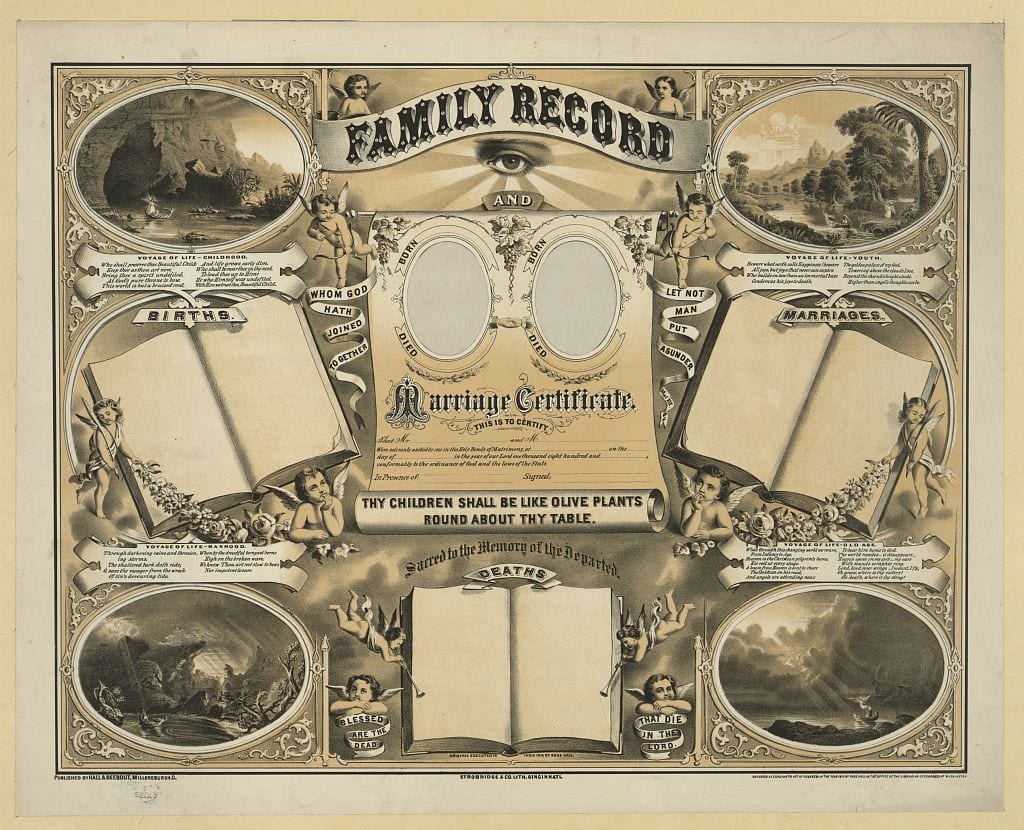There was a solid if unspectacular increase in the number of academic job opportunities for new history Ph.D.’s last year, as departments replaced a growing number of retirees or simply added new faculty.
Although the job market for historians has improved steadily over the past three years, a closer look at the job offerings indicates that the proportion of jobs available for junior faculty has been growing even faster. Last year there were more positions for faculty seeking jobs at the lecturer or assistant professor level than in any year since the 1990-91 academic year. Although the total number of jobs advertised in Perspectives between September 1996 and May 1997 was still below the level of five years ago (709 last year as compared to 784 in 1991-92), the offerings for junior faculty were actually higher (562 as opposed to 558). At the same time, the proportion of tenure-track jobs rose from 74 percent in 1995-96 to just over 80 percent last year.
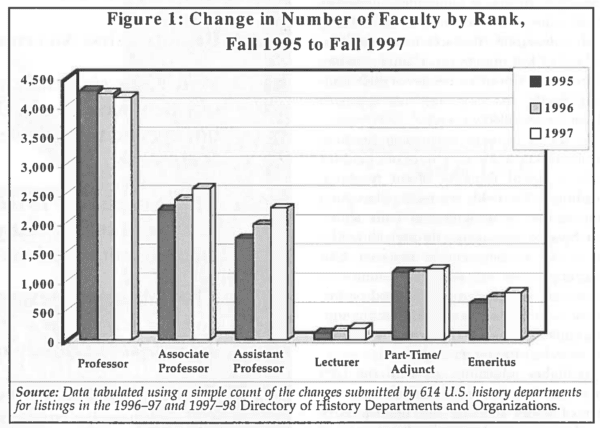 In a survey last fall, a majority of department chairs expressed concern about whether they could replace retiring faculty, and very few anticipated that they would be able to add new faculty to the department. However, data collected for the next edition of the Directory of History Departments suggests that, at least for this year, the pessimism was unwarranted, as the number of full-time historians listed in the Directory increased by 5 percent for the second year in a row. In the 614 U.S. history departments listed in both the 1996-97 and 1997-98 editions of the Directory, the total number of full-time faculty rose from 8,773 to 9,229. As reflected in Table 1, this was predicated on a slight decline in the number of full professors that was more than offset by the hiring and promotion of faculty at the assistant professor rank. More than 5 percent of faculty at the full professor level (250 in all) left their departments or shifted to emeritus status. In contrast, 413 new faculty were hired at the assistant professor level, and another 226 were promoted from the assistant to associate level. This significantly outpaced the 153 assistant professors who left their departments, and as a result, the number of faculty at the assistant professor level rose 14 percent over the year before.
In a survey last fall, a majority of department chairs expressed concern about whether they could replace retiring faculty, and very few anticipated that they would be able to add new faculty to the department. However, data collected for the next edition of the Directory of History Departments suggests that, at least for this year, the pessimism was unwarranted, as the number of full-time historians listed in the Directory increased by 5 percent for the second year in a row. In the 614 U.S. history departments listed in both the 1996-97 and 1997-98 editions of the Directory, the total number of full-time faculty rose from 8,773 to 9,229. As reflected in Table 1, this was predicated on a slight decline in the number of full professors that was more than offset by the hiring and promotion of faculty at the assistant professor rank. More than 5 percent of faculty at the full professor level (250 in all) left their departments or shifted to emeritus status. In contrast, 413 new faculty were hired at the assistant professor level, and another 226 were promoted from the assistant to associate level. This significantly outpaced the 153 assistant professors who left their departments, and as a result, the number of faculty at the assistant professor level rose 14 percent over the year before.
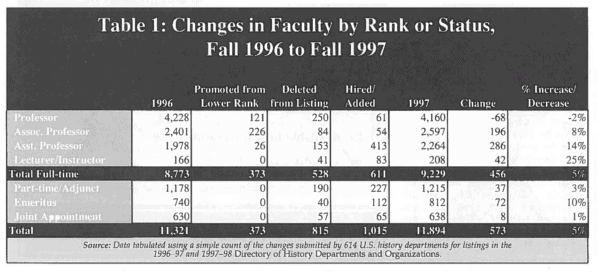 Moreover, the data indicates that this is a wide-ranging improvement, reaching into every region of the country. Unlike the recent bouts of downsizing, the improvements last year were not limited to specific regions of the country or particular types of institutions. The increases in the number of full-time faculty were distributed fairly evenly throughout the country. However, the areas that suffered the worst of the downsizing just a few years ago were among the most improved in this survey, including colleges and universities in the Northeast, and public institutions in the West (Table 2).
Moreover, the data indicates that this is a wide-ranging improvement, reaching into every region of the country. Unlike the recent bouts of downsizing, the improvements last year were not limited to specific regions of the country or particular types of institutions. The increases in the number of full-time faculty were distributed fairly evenly throughout the country. However, the areas that suffered the worst of the downsizing just a few years ago were among the most improved in this survey, including colleges and universities in the Northeast, and public institutions in the West (Table 2).
However, the increase in new jobs available for the fall 1997 term did not noticeably ease the level of competition. Less than two-thirds of the newly hired assistant professors received their degree within the past three years. Only 28 percent received their degrees this past May, 25 percent completed in 1996, and 12 percent finished in 1995. A substantial number of hires, almost 10 percent, received their Ph.D.’s before 1990.
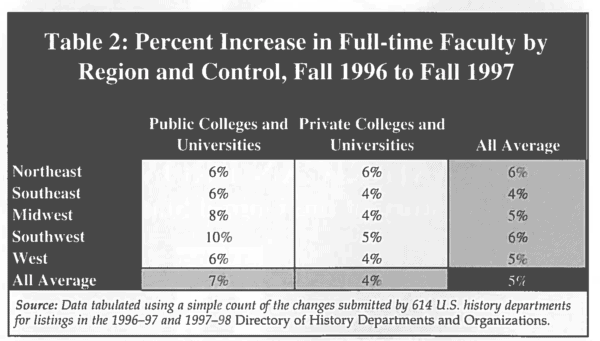 The diversity of years in which new junior faculty received their Ph.D.’s provides some indication of the large numbers who have been “underemployed” in part-time positions, employed outside the academy, or seeking to change jobs. According to a just-released survey of humanities Ph.D.’s, in 1995, 7.5 percent of all history Ph.D.’s in the labor force were employed part-time and 1.8 percent were unemployed. While the unemployment rate was higher for those who received the Ph.D. between 1990 and 1994 3 percent), a smaller proportion of recent Ph.D.’s 6 percent) were working part-time. (For more on this survey see the news item “History Ph.D.’s Lose Edge in Latest NRC Survey” on page 3.)
The diversity of years in which new junior faculty received their Ph.D.’s provides some indication of the large numbers who have been “underemployed” in part-time positions, employed outside the academy, or seeking to change jobs. According to a just-released survey of humanities Ph.D.’s, in 1995, 7.5 percent of all history Ph.D.’s in the labor force were employed part-time and 1.8 percent were unemployed. While the unemployment rate was higher for those who received the Ph.D. between 1990 and 1994 3 percent), a smaller proportion of recent Ph.D.’s 6 percent) were working part-time. (For more on this survey see the news item “History Ph.D.’s Lose Edge in Latest NRC Survey” on page 3.)
Competition Still Tight in the Largest Fields
A comparison of the specializations of new Ph.D.’s and new jobs available in 1996 shows the substantial disparities between jobs and candidates in U.S. and European history, as growth in the production of new Ph.D.’s continues to outpace the increase in the number of new jobs.
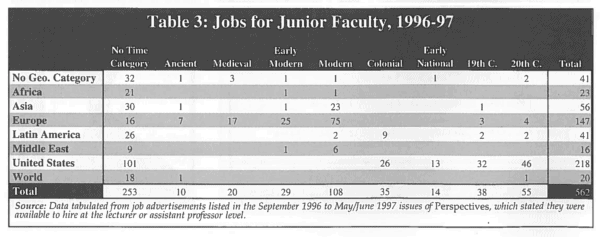 In the largest areas of specialization, especially 20th-century U.S. and modem European history, job offerings will have to increase much faster before the competition begins to ease. Forty percent of the jobs offered last year were for some category of U.S. history, while another 24 percent were for specialists in European history. Twelve percent did not request a specific geographic specialization, typically asking instead for a particular thematic specialty. The rest of the world only accounted for 25 percent of the jobs offered, with nine percent of the jobs for Asian history specialists, 6 percent for Latin America, 4 percent for specialists in world history, and three percent each for Africa and the Middle East. The offerings for junior faculty closely corresponded to this breakdown, except that considerably more of the advertisements specified a specific geographic specialization (Table 3).
In the largest areas of specialization, especially 20th-century U.S. and modem European history, job offerings will have to increase much faster before the competition begins to ease. Forty percent of the jobs offered last year were for some category of U.S. history, while another 24 percent were for specialists in European history. Twelve percent did not request a specific geographic specialization, typically asking instead for a particular thematic specialty. The rest of the world only accounted for 25 percent of the jobs offered, with nine percent of the jobs for Asian history specialists, 6 percent for Latin America, 4 percent for specialists in world history, and three percent each for Africa and the Middle East. The offerings for junior faculty closely corresponded to this breakdown, except that considerably more of the advertisements specified a specific geographic specialization (Table 3).
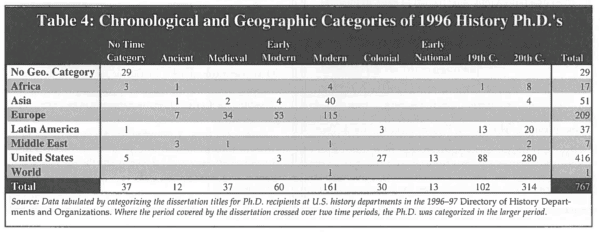 Using the AHA’s taxonomy of specializations, staff categorized the field specializations for 1996 Ph.D. recipients based on the titles of dissertations listed in the 1996-97 Directory. These results were then placed alongside a detailed survey of instructor-and assistant-professor-level job openings listed in Perspectives from September 1996 to May/June 1997. As Figure 2 indicates, the number of new Ph.D.’s in modem European and most periods of U.S. history is vastly outpacing the number of new jobs in these fields. This is particularly evident when supply and demand for openings in Europe and the United States is compared to that for other areas.
Using the AHA’s taxonomy of specializations, staff categorized the field specializations for 1996 Ph.D. recipients based on the titles of dissertations listed in the 1996-97 Directory. These results were then placed alongside a detailed survey of instructor-and assistant-professor-level job openings listed in Perspectives from September 1996 to May/June 1997. As Figure 2 indicates, the number of new Ph.D.’s in modem European and most periods of U.S. history is vastly outpacing the number of new jobs in these fields. This is particularly evident when supply and demand for openings in Europe and the United States is compared to that for other areas.
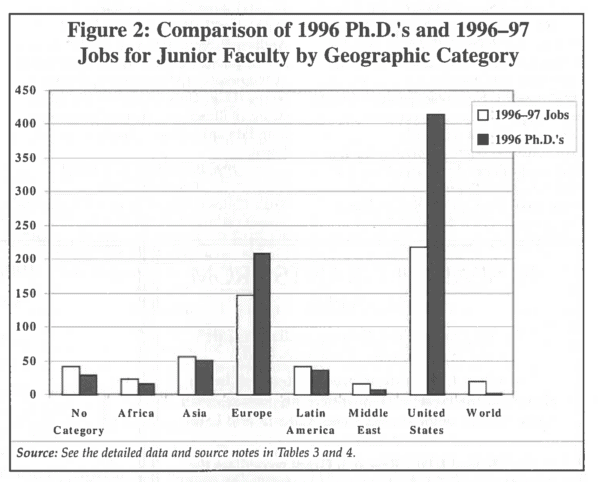 When viewed along the axes of chronology and geography, staff found that 20th-century U.S. history continues to be the most popular field of study, as 280 Ph.D. recipients accounted for almost 37 percent of all degrees conferred. This represents a significant increase from the 24 percent found in a survey of 1993 Ph.D. recipients. Modern Europe came in a distant second, with 115 new Ph.D.’s, followed by 19th-century U.S. history, with 88 degree recipients.
When viewed along the axes of chronology and geography, staff found that 20th-century U.S. history continues to be the most popular field of study, as 280 Ph.D. recipients accounted for almost 37 percent of all degrees conferred. This represents a significant increase from the 24 percent found in a survey of 1993 Ph.D. recipients. Modern Europe came in a distant second, with 115 new Ph.D.’s, followed by 19th-century U.S. history, with 88 degree recipients.
Unfortunately, although the bulk of the jobs available were for specialists in these categories, there was a pronounced disparity between jobs and new Ph.D.’s. As reflected in Tables 3 and 4, in 20th-century U.S. history the 280 new Ph.D.’s compare quite unfavorably with the 42 job offerings available for junior faculty later that fall. The ratios of job.to new Ph.D.’s was only slightly better in modern European (115 Ph.D.’s versus 75 openings) and 19th-century U.S. history (88 Ph.D.’s and 32 jobs). However, in U.S. history, these disparities are somewhat mitigated by the availability of 101 offerings for thematic rather than chronological specializations, the largest portion of which were for African American (24) or women’s history (9).
By contrast, for colonial America, premodern Europe, and the other continents of the world there was a ratio of near or better than one junior faculty job for every Ph.D. produced in 1996. In Asian history, for instance, there were 51 dissertations in the broad category of Asian history, set against 56 openings.
A survey of future Ph.D. candidates offers little prospect of change in these patterns of specialization. A survey of dissertations in progress in the 1996-97 Directory found that 29 percent of those working toward Ph.D.’s are working in 20th-century U.S. history. Another 16 percent are working in modem European history. However, almost 20 percent of the Ph.D.-granting departments do not supply lists of dissertations in progress, so there is no way to provide a firm estimate on the number of Ph.D. candidates; there could be some variation in the exact ratios. Nevertheless, the overall pattern appears to be consistent.
It should be noted that slightly more than 20 percent of the jobs advertised in Perspectives were not reflected in the hires listed in the Directory. A cross-tabulation of the two lists indicates that most of these job offerings were not in history departments, but rather in area studies or other specialized departments (including religious studies, Jewish studies, African and African American studies, and women’s studies), The rest were in very small history, humanities, or social sciences departments that chose not to list in either the 1996-97 or edition of the Directory, and hence could not be tabulated in the year-to-year comparison. With only a handful of exceptions, departments in the Directory had advertised all the openings for which they hired new faculty in Perspectives.
Competition for Academic Jobs Not Likely to Ease
The NRC survey cited above reflects increased numbers of history Ph.D.’s finding employment in the academy—in 1995 there were 15,600 historians employed in the academy, the largest number ever recorded in the NRC surveys. However, the supply of recent Ph.D.’s into the academic job market continues to produce tight competition for each new job. Even as the number of historians employed in four-year colleges and universities rose, their proportion of employed history Ph.D.’s fell to the lowest level on record-just 64.4 percent. And there is little evidence in the NRC or AHA data to suggest the competition will significantly ease in the near future.
Given the large numbers admitted to history graduate programs in the late 1980s and early 1990s that have yet to complete their degrees—most of whom are being prepared for academic employment—the supply of new Ph.D.’s is likely to remain high. (History has produced an average of 735 new Ph.D.’s a year since 1990.)1 As a best-case scenario, using the NRC data it can be estimated that close to 15 percent of the historians employed in the academy will retire over the next five years,—since evidence indicates that most faculty will retire before the age of 70 even without a mandatory retirement age.2 If that comes to pass, and all available positions are refilled, it would open up around 2,400 new academic history jobs, well below the number of new Ph.D.’s that would be produced at current rates. Moreover, as of 1995 there were more than 7,000 history Ph.D.’s employed outside the academy, many of whom are still interested in and trained for jobs in the academy. Thus, the academic job market may well continue to improve, but the competition for each academic job will ease only very slowly.
Notes
- For more on the trends in enrollment and Ph.D. production, see Robert B. Townsend, “Job Report 1997,” Perspectives (April 1997): 7. [↩]
- See Denise K. Magner, “An Aging Faculty Poses a Challenge for Colleges,” Chronicle of Higher Education (August 8, 1997): A10, and William Bowen and Julie Ann Sosa, Prospects for Faculty in the Arts & Sciences (New York: Princeton Univ. Press, 1989), as well as Linda Ingram and Prudence Brown, Humanities Doctorates in the United States: 1995 Profile (National Academy Press: Washington, D.C., 1997). [↩]

